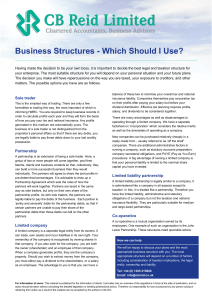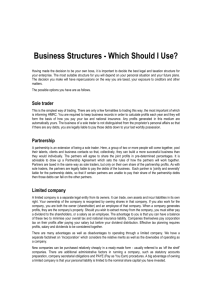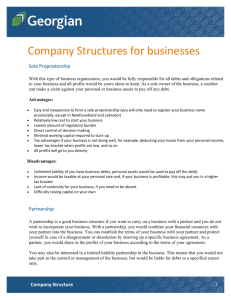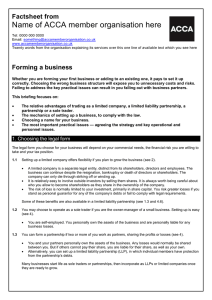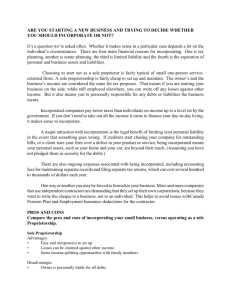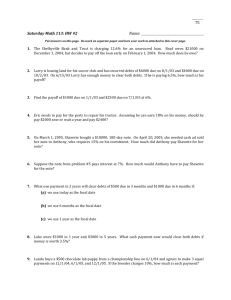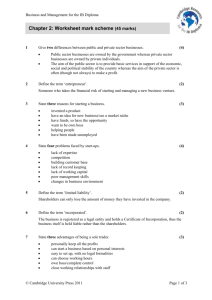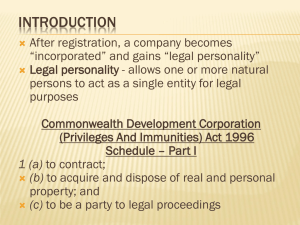Business Structure - Lindbeck Partners
advertisement
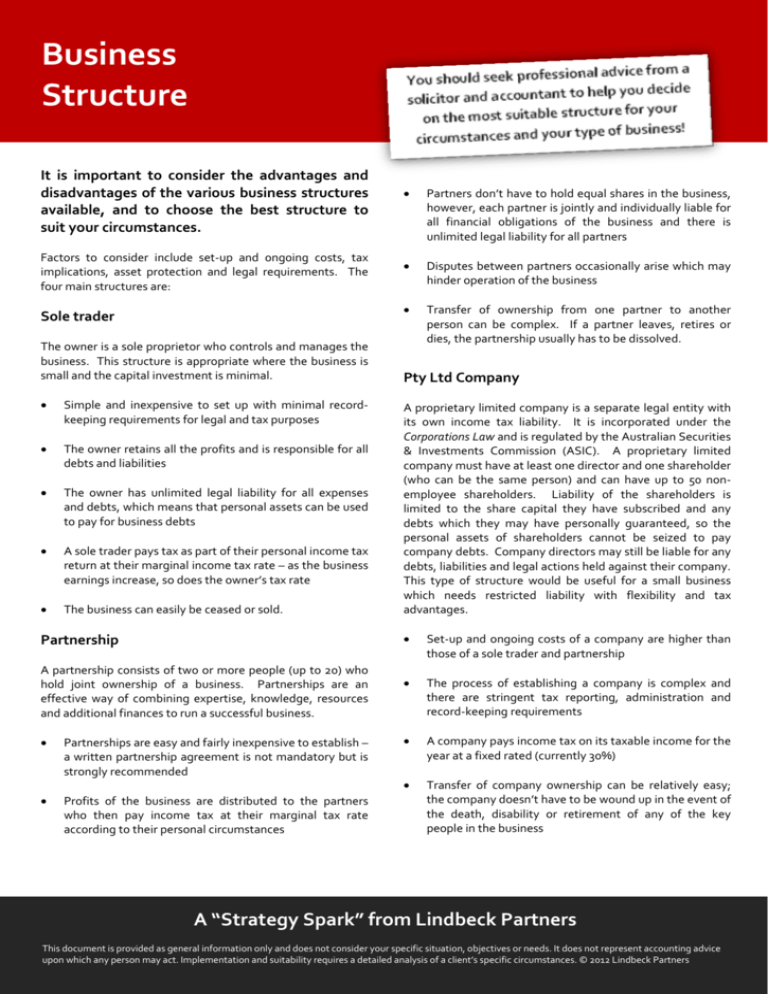
Business Structure It is important to consider the advantages and disadvantages of the various business structures available, and to choose the best structure to suit your circumstances. Factors to consider include set-up and ongoing costs, tax implications, asset protection and legal requirements. The four main structures are: Sole trader The owner is a sole proprietor who controls and manages the business. This structure is appropriate where the business is small and the capital investment is minimal. · Simple and inexpensive to set up with minimal recordkeeping requirements for legal and tax purposes · The owner retains all the profits and is responsible for all debts and liabilities · The owner has unlimited legal liability for all expenses and debts, which means that personal assets can be used to pay for business debts · A sole trader pays tax as part of their personal income tax return at their marginal income tax rate – as the business earnings increase, so does the owner’s tax rate · The business can easily be ceased or sold. Partnership A partnership consists of two or more people (up to 20) who hold joint ownership of a business. Partnerships are an effective way of combining expertise, knowledge, resources and additional finances to run a successful business. · Partnerships are easy and fairly inexpensive to establish – a written partnership agreement is not mandatory but is strongly recommended · Profits of the business are distributed to the partners who then pay income tax at their marginal tax rate according to their personal circumstances · Partners don’t have to hold equal shares in the business, however, each partner is jointly and individually liable for all financial obligations of the business and there is unlimited legal liability for all partners · Disputes between partners occasionally arise which may hinder operation of the business · Transfer of ownership from one partner to another person can be complex. If a partner leaves, retires or dies, the partnership usually has to be dissolved. Pty Ltd Company A proprietary limited company is a separate legal entity with its own income tax liability. It is incorporated under the Corporations Law and is regulated by the Australian Securities & Investments Commission (ASIC). A proprietary limited company must have at least one director and one shareholder (who can be the same person) and can have up to 50 nonemployee shareholders. Liability of the shareholders is limited to the share capital they have subscribed and any debts which they may have personally guaranteed, so the personal assets of shareholders cannot be seized to pay company debts. Company directors may still be liable for any debts, liabilities and legal actions held against their company. This type of structure would be useful for a small business which needs restricted liability with flexibility and tax advantages. · Set-up and ongoing costs of a company are higher than those of a sole trader and partnership · The process of establishing a company is complex and there are stringent tax reporting, administration and record-keeping requirements · A company pays income tax on its taxable income for the year at a fixed rated (currently 30%) · Transfer of company ownership can be relatively easy; the company doesn’t have to be wound up in the event of the death, disability or retirement of any of the key people in the business A “Strategy Spark” from Lindbeck Partners This document is provided as general information only and does not consider your specific situation, objectives or needs. It does not represent accounting advice upon which any person may act. Implementation and suitability requires a detailed analysis of a client’s specific circumstances. © 2012 Lindbeck Partners Business Structure Trust A trust is an arrangement where one party, the trustee (either a person or a company), carries on business and holds assets for the benefit of the other parties, the beneficiaries. The most common form of trust is a discretionary trust, also known as a family trust. All income of the business goes into the trust and the trustee has the power to decide how to distribute the income to the beneficiaries. The rules by which the trust is managed are contained in a trust deed. · Ownership of the business by a corporate trustee provides asset protection and limits liability in relation to the business · Beneficiaries of a trust pay tax on income they receive from a trust at their own marginal rates, therefore, income distributed to children under 18 may be taxed at higher rates than adults · · Beneficiaries of a trust are generally not liable for the debts of the trust – assets of the trust may be controlled by the beneficiaries but they are not owned by them. A trust is a complex structure which has to comply with specific regulations, so establishing a trust needs to be done by a solicitor or accountant – this can be expensive YOUR ACTION PLAN £ Make an appointment with your accountant and solicitor for advice on choosing the best structure for your business. £ Ask about: o Establishments costs o Maintenance costs o Record-keeping and reporting requirements o Tax implications o Asset protection o Selling, leaving or transferring ownership of the business Contact Lindbeck Partners team today on 02 49544611 for assistance with this Action Plan! A “Strategy Spark” from Lindbeck Partners This document is provided as general information only and does not consider your specific situation, objectives or needs. It does not represent accounting advice upon which any person may act. Implementation and suitability requires a detailed analysis of a client’s specific circumstances. © 2012 Lindbeck Partners

